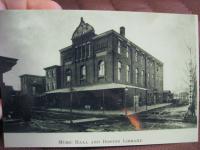One of the very first repositories whose holdings we surveyed for the HCI-PSAR project was the Historical Society of Tacony. Right away, I felt the mission of our project validated: the Historical Society of Tacony houses a small number of collections, but its unique materials are a vital and untapped resource for researchers. Here are a few things I learned about Tacony:
- Tacony was home to the inventor of the world's first solar power plant.
- A Tacony-based company cast the iconic William Penn statue now perched atop Philadelphia's City Hall.
- Tacony was Utopia.
Well, that last one may be a bit of an exaggeration. But certainly the vision for a utopia was there.
When Henry Disston moved his saw manufactory to Tacony in the 1870s, he sought to establish a company town that would be "a paradise for the working man of moderate means." The Disston family built quality homes that they rented cheaply to company workers; they restricted businesses on their lands to keep out smelly industries like tanneries, and to keep the town dry by forbidding the sale of alcohol; they funded a free library, a post office, and public parks. One of the buildings funded by the Disstons was the Tacony Music Hall and Library, a registered National Historic Landmark, which was recently restored and currently houses the Historical Society of Tacony. The Historical Society of Tacony's holdings feature Disston company newsletters and catalogs, as well as manuscripts and photographs from several members of the Disston family, including Dorothea Disston James and Thomas Winfield South.
Henry Disston & Sons, Inc. may have been the most socially responsible business in town, but they weren't even the only metal company operating in Tacony at the turn of the twentieth century.Tacony Iron and Metal Works cast the enormous statue of William Penn that currently towers over the City of Philadelphia before going out of business in 1909. The grounds were later taken over by Dodge Steel Company, now also defunct.



